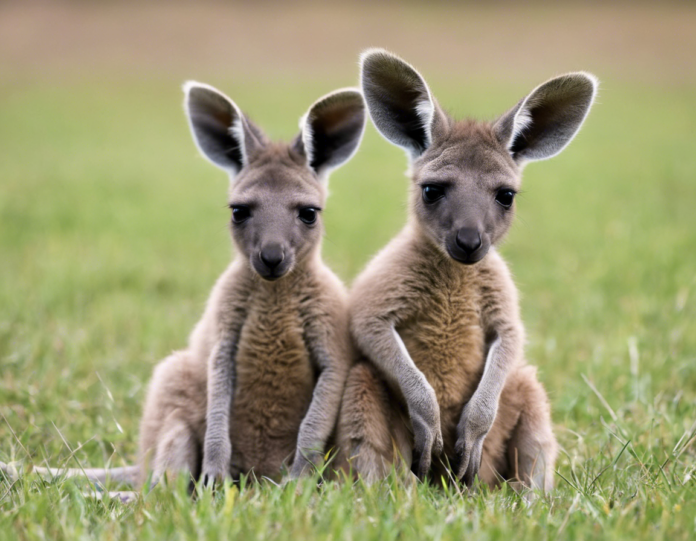If there's one animal that symbolizes the beauty of the Australian wildlife, it's the lovable kangaroo. Known for their powerful hind legs built for hopping, pouch for carrying young, and strong tails for balance, these iconic marsupials are a sight to behold. One of the most endearing facts about kangaroos is the unique term used to describe their offspring - a baby kangaroo is called a joey.
Understanding the Joey
What is a Joey?
A joey is the term used to refer to a baby kangaroo. When a female kangaroo becomes pregnant, the gestation period is approximately 30-36 days. After a short period of gestation, the tiny, underdeveloped baby, which is only the size of a jellybean, is born. The joey then makes its way through its mother's fur, finds her pouch, and attaches itself to one of her teats where it continues to grow and develop.
Life in the Pouch
The kangaroo's pouch provides a safe and nurturing environment for the joey where it can continue to develop and grow. It spends up to nine months in its mother's pouch, depending on the kangaroo's species. During this time, the joey gradually becomes more independent, beginning to venture out of the pouch for short periods before eventually leaving it for good.
Maternal Care
Female kangaroos, also known as does, are incredibly nurturing mothers. They produce two types of milk simultaneously to cater to the different needs of their young. One type is a more nourishing milk for the older joey outside the pouch, while the other is a less nutritious variety for the joey still developing inside the pouch. This adaptive milk production ensures both offspring receive the appropriate nourishment for their stage of development.
Growing Up
As the joey grows, it becomes too big for its mother's pouch and starts to explore the world outside. Initially, it may jump in and out of the pouch, gradually spending more time outside until it no longer needs the pouch for protection or sustenance. At this stage, it's considered a fully independent kangaroo.
Types of Joeys
Depending on the specific species of kangaroo, there are different names for joeys at different stages of their development. For example, a baby kangaroo born prematurely, which then climbs into its mother's pouch to continue developing, is known as a pinky. Once the joey is firmly attached to the teat inside the pouch and has started developing more, it is commonly referred to as a hairless joe. As the joey continues to grow and develop fur, it transitions into the furred joey stage.
FAQs about Joeys
1. How long does a joey stay in its mother's pouch?
A joey typically stays in its mother's pouch for up to nine months, depending on the kangaroo species.
2. Can joeys survive outside the pouch?
After spending time in the pouch for development, joeys gradually become more independent, eventually leaving the pouch for good when they are ready.
3. What is a baby kangaroo called before it enters the pouch?
A baby kangaroo born prematurely is known as a pinky.
4. How does a joey attach itself to the teat inside the pouch?
A joey instinctively crawls through its mother's fur into the pouch and latches onto a teat, where it receives nourishment and continues to grow.
5. Do joeys of different species have distinct names?
Yes, depending on the species of kangaroo, there are different terms used to describe joeys at various stages of development, such as pinkies, hairless joes, and furred joes.
6. How do mother kangaroos care for their joeys?
Female kangaroos produce two types of milk simultaneously to cater to the different needs of their young, ensuring that both offspring, whether in or out of the pouch, receive the appropriate nourishment.
7. At what stage is a joey considered fully independent?
A joey is considered fully independent when it no longer needs the pouch for protection or sustenance and can survive on its own in the wild.
8. Can joeys jump back into the pouch for safety?
Even after leaving the pouch, joeys may jump back inside for safety, warmth, or comfort, especially when they feel threatened or insecure.
9. How do joeys learn to jump and hop?
Young joeys observe and imitate their mothers, gradually learning to use their powerful hind legs for hopping and their tails for balance as they grow older and more independent.
10. What are some interesting facts about joeys?
Apart from being adorable and iconic symbols of Australian wildlife, joeys play a crucial role in maintaining the balance of their ecosystems by grazing on vegetation, spreading seeds, and supporting biodiversity through their interactions with other animals in their habitats.
In conclusion, the term joey not only represents a stage in the development of a baby kangaroo but also embodies the resilience and adaptability of these remarkable marsupials. From their initial days inside the pouch to their eventual independence in the wild, joeys symbolize the beauty and wonder of nature's creations.

